|
|
Radium Dials By Roger Russell |
|
Copyright 1996-2004 by Roger Russell
All rights reserved
No portion of this site may be reproduced in whole or in part
without written permission of the author.
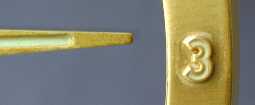 Early Jefferson
Golden Hour, Golden Minute and Golden View clocks have luminescent paint
applied to the hands and numerals on the dials. It can be seen in the photo at
the left as a very light greenish white. The luminescent material is actually
radium paint and it is radioactive. Jefferson sales literature
mentions that radium is used. Measurements made recently on these old clocks,
using a Geiger counter, show the levels to be extremely low and are NOT
considered a hazard. On contact with the minute hand the dose rate is 1
mR/hour. At a distance of one foot, the dose rate is about 0.008 mR/hour. This
is about the same level found for old radium dial wristwatches. Production of
the Golden Hour began in December of 1949 and luminescent paint has been found
on Golden Hours as late as 1965.
Early Jefferson
Golden Hour, Golden Minute and Golden View clocks have luminescent paint
applied to the hands and numerals on the dials. It can be seen in the photo at
the left as a very light greenish white. The luminescent material is actually
radium paint and it is radioactive. Jefferson sales literature
mentions that radium is used. Measurements made recently on these old clocks,
using a Geiger counter, show the levels to be extremely low and are NOT
considered a hazard. On contact with the minute hand the dose rate is 1
mR/hour. At a distance of one foot, the dose rate is about 0.008 mR/hour. This
is about the same level found for old radium dial wristwatches. Production of
the Golden Hour began in December of 1949 and luminescent paint has been found
on Golden Hours as late as 1965.
PLEASE NOTE
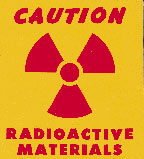 The
symbol in this pictures is used to indicate radioactivity and radioactive
materials. This warning may not have been required for watches and clocks many
years ago. Today, the amount of radioactive material may be considered too
small to warrant a label, either. The paint is harmless on the clocks as it is,
but for some reason, if you decide to take the paint off, treat it like
radioactive material and dispose it according to approved government
regulations for discarding hazardous materials. Don't breathe the dust or
handle the scrapings.
The
symbol in this pictures is used to indicate radioactivity and radioactive
materials. This warning may not have been required for watches and clocks many
years ago. Today, the amount of radioactive material may be considered too
small to warrant a label, either. The paint is harmless on the clocks as it is,
but for some reason, if you decide to take the paint off, treat it like
radioactive material and dispose it according to approved government
regulations for discarding hazardous materials. Don't breathe the dust or
handle the scrapings.
According to the National Council on Radiation Protection and Measurements, the continuous or frequent annual external radiation exposure to a population should not exceed 100 millirem per year. A limit of 500 millirem per year for an individual should be applied for an infrequent annual exposure.
The paint is composed of radium, zinc sulfide and a glue binder. The zinc sulfide emits light when struck by the radioactive particles. It glows all night and exposure to light is not necessary. This paint was used on many different products made by several different companies until its use was banned. The clocks I have glow, but very faintly. The zinc sulfide may have deteriorated over the years but it's unlikely the radium has decayed. Remember that the half-life of radium is 1600 years!
 Radium paint
was popular long before Jefferson began using it. In The Literary Digest for
November 13, 1920, a full-page ad for radium products can be found on page 65.
It is called UNDARK (trade name applied for) and made by the Radium Luminous
Material Corporation, 58 Pine Street, New York City. The factory was in Orange,
NJ and the mines were in Colorado and Utah. It was recommended for all kinds of
uses such as watches, clocks, doorbell buttons, fish bait, gauges, theater seat
numbers, fire extinguishers and poison labels. A "try-out" set was
available for $3.00 through the mail.
Radium paint
was popular long before Jefferson began using it. In The Literary Digest for
November 13, 1920, a full-page ad for radium products can be found on page 65.
It is called UNDARK (trade name applied for) and made by the Radium Luminous
Material Corporation, 58 Pine Street, New York City. The factory was in Orange,
NJ and the mines were in Colorado and Utah. It was recommended for all kinds of
uses such as watches, clocks, doorbell buttons, fish bait, gauges, theater seat
numbers, fire extinguishers and poison labels. A "try-out" set was
available for $3.00 through the mail.
Radium dial painting began in 1917 but it was deadly for the dialpainters.
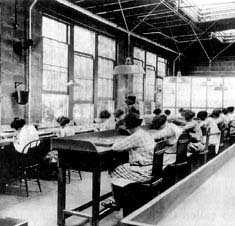 Young
women ranging in age from the mid teens to the early 20's were employed to
apply the paint to clock dials and other products for several different
companies. The dialpainters were typically single and lived with their parents.
Dialpainting was easy work with comparatively high wages. Over the first 10
years about 2000 women were employed in this work, mostly in three locations:
Orange, NJ, Waterbury, CT and Ottawa, IL. The picture at the left was taken in
the 1920's at the Orange, NJ facility. Photo courtesy of Argonne National
Laboratory.
Young
women ranging in age from the mid teens to the early 20's were employed to
apply the paint to clock dials and other products for several different
companies. The dialpainters were typically single and lived with their parents.
Dialpainting was easy work with comparatively high wages. Over the first 10
years about 2000 women were employed in this work, mostly in three locations:
Orange, NJ, Waterbury, CT and Ottawa, IL. The picture at the left was taken in
the 1920's at the Orange, NJ facility. Photo courtesy of Argonne National
Laboratory.
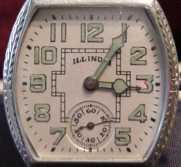 The
earliest dialpainters had come from the china painting industry. Workers were
required to use lippointing to bring the paintbrushes to a point between the
lips. This practice was passed on to the radium painting industry that also
needed fine work. The majority of dialpainting was for wristwatches. The watch
at the right was made in the late 1920's by Illinois Watch, Springfield,
Illinois. The painting is done exceptionally well.
The
earliest dialpainters had come from the china painting industry. Workers were
required to use lippointing to bring the paintbrushes to a point between the
lips. This practice was passed on to the radium painting industry that also
needed fine work. The majority of dialpainting was for wristwatches. The watch
at the right was made in the late 1920's by Illinois Watch, Springfield,
Illinois. The painting is done exceptionally well.
This radium dial was probably painted by a dialpainter that later may have suffered and/or died as a result of having painted the numbers and hands on this and other watch dials. By the 1920's and 1930's some dialpainters and former dialpainters began to suffer from a variety of illnesses, often crippling and frequently fatal as a result of ingesting the radium paint. Ingested radium is known to deposit permanently in bone structures. Radiation can then damage bone marrow, causing anemia. It can also weaken the bones so they might crush or snap under normal pressure. It can weaken bone tissue making it easy to get infection such as the jawbones that have dental work or gum disease. It can cause other forms of cancer in the sinus and mastoids.
The dialpainters were some of the first victims of radioactive poisoning. Earlier, Marie Curie, who first discovered radium in 1898, died from leukemia, which in all probability was caused by her long exposure to radium. Sabin Von Sochocky discovered a luminous paint formula that included radium and founded a company that sold luminous clock and watch dials. He died from aplastic anemia, also likely caused by radium exposure.
It isn't clear how well known the dangers of radium were in 1917 but no warning was given to the workers. The radium companies denied the dangers of imbibing radium despite the consensus of opinion among most medical experts and government officials that it was dangerous. The dialpainters were such a minority and lacked any financial resources to have any clout in dealing with industry. The battle for recognition of this health hazard to these women went on for many years.
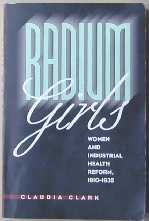 A book
titled "Radium Girls: Women and Industrial health reform, 1910-1935"
by Claudia Clark was published by The University of North Carolina press, Chapel
Hill and London in 1997 (ISBN 0-8078-2331-7 cloth and ISBN 0-8078-4640-6
paperback.) This is an excellent source of information on the subject. It is
well documented with many references and an extensive bibliography.
A book
titled "Radium Girls: Women and Industrial health reform, 1910-1935"
by Claudia Clark was published by The University of North Carolina press, Chapel
Hill and London in 1997 (ISBN 0-8078-2331-7 cloth and ISBN 0-8078-4640-6
paperback.) This is an excellent source of information on the subject. It is
well documented with many references and an extensive bibliography.
A 1-3/4 hour film titled "Radium City" was made in 1986 about the aftereffects of two radium dial painting companies based in Ottawa, Illinois. The city of Ottawa, IL is about 80 miles southwest of Chicago. The Radium Dial Company (RDC) moved from the East Coast to Ottawa in 1922. Joseph Kelly was president. The first problems of radiation exposure occurred with the young women who applied the radium paint to the dials. According to the film, RDC went out of business in 1934 after being faced by many lawsuits. Luminous Process Incorporated (LPI) started soon after also headed by Kelly. It operated from 1932 to 1978 when the NRC shut it down. Both factories were demolished, RDC in 1969 and LPI in1984 and much of the material was used as land fill. As a result there are 13 areas today with above normal radiation in Ottawa. The major contaminant is radium-226 and the by-product, radon-222. For more information see the Petitioned Public Health Assessment, Ottawa Radiation Areas, Ottawa, Lasalle County, Illinois
It isn't known if the radium dials used by Jefferson starting in 1949 were painted by their employees or even done by Jefferson at all. They may have been sent out to be painted. In any case, working conditions were improved by that time but use of the paint was eventually banned.
New Materials
![]() Today, a new
material is used in wristwatches, aircraft instruments, etc. This is a
radioactive isotope of hydrogen called tritium. It originally had been used to
increase the yield of atomic weapons. Tritium is a gas and has a half-life of
12.43 years. It decays into a stable non-radioactive form. In commercial use,
the gas is put in tiny vials of borosilicate glass that is internally coated
with phosphor and sealed by a laser. These assemblies are referred to as
radio-luminescent light sources, also known as Gaslights or Trasers. The vials
can be made so small that they can be placed on the watch hands and at each
hour on the dial.
Today, a new
material is used in wristwatches, aircraft instruments, etc. This is a
radioactive isotope of hydrogen called tritium. It originally had been used to
increase the yield of atomic weapons. Tritium is a gas and has a half-life of
12.43 years. It decays into a stable non-radioactive form. In commercial use,
the gas is put in tiny vials of borosilicate glass that is internally coated
with phosphor and sealed by a laser. These assemblies are referred to as
radio-luminescent light sources, also known as Gaslights or Trasers. The vials
can be made so small that they can be placed on the watch hands and at each
hour on the dial.
Unlike radium paint, tritium gas emits only low energy beta particles (electrons) that are unable to penetrate the borosilicate glass vials. This makes their use completely safe. The non-radioactive phosphors used today must be exposed to light or to some other energy source. Trasers glow constantly by themselves, even in total darkness and require no energy source other than the radioactive gas. Trasers are commonly made with green and yellow phosphors that can most easily seen. Other colors include orange, red and blue. Other uses are emergency exit signs.
![]()
Radium
Symbol:Ra
Atomic Number:88
Atomic Mass:226
Half Life: 1600 years
![]()
|
About This Site |
||
|
More text and pictures about radioactive dials will be added as my research continues. Any comments, corrections, or additions are welcome. |
||
|
Created by Roger Russell |
||
